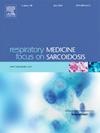奶牛场主和吸烟者慢性阻塞性肺疾病的计算机断层扫描特征
IF 3.1
3区 医学
Q2 CARDIAC & CARDIOVASCULAR SYSTEMS
引用次数: 0
摘要
目的评估与奶牛养殖相关的慢性阻塞性肺疾病(COPD)与吸烟相关的COPD和混合暴露性COPD相比,是否表现出不同的胸部计算机断层扫描(CT)特征。材料和方法我们分析了一项前瞻性单中心队列COPD患者的数据,将其分为三组:不吸烟的奶农(F-COPD)、吸烟的奶农(M-COPD)和无职业暴露的吸烟相关COPD个体(S-COPD)。所有参与者在纳入时均接受胸部CT检查。两名放射科医生,不知道暴露状态,使用标准化标准独立评估成像特征。结果共纳入85例患者,平均年龄67±9岁;72例(85%)为男性。F-COPD患者肺气肿发生率(54.2%)明显低于M-COPD患者(80.8%)和S-COPD患者(80.0%)(p = 0.05)。膈旁肺气肿在f型copd中几乎不存在(7%),但在m型copd(57%)和s型copd(75%)中普遍存在(p < 0.001)。F-COPD患者粘液堵塞评分最高(1.17±1.16),M-COPD次之(0.80±1.05),S-COPD次之(0.37±0.77)(p = 0.04)。吸烟相关的特征,如气道扩大伴纤维化和肺结节在F-COPD中明显不常见。m型copd患者的烟草暴露低于s型copd患者(p = 0.02)。结论f - copd表现出明显的气道显性ct表型,伴有明显的粘液堵塞和有限的肺气肿,提示奶牛养殖中慢性暴露于有机粉尘和生物气溶胶导致的不同病理生理机制。这些发现支持使用胸部CT进行暴露特异性表型分析,并强调职业性COPD需要量身定制的治疗方法。本文章由计算机程序翻译,如有差异,请以英文原文为准。
Distinctive computed tomography features of chronic obstructive pulmonary disease among dairy farmers and smokers
Purpose
To assess whether Chronic Obstructive Pulmonary Disease (COPD) associated with dairy farming presents distinct chest computed tomography (CT) features compared to smoking-related COPD and mixed-exposure COPD.
Materials and methods
We analyzed data from a prospective monocentric cohort of COPD patients categorized into three groups: non-smoking dairy farmers (F-COPD), smoking dairy farmers (M-COPD), and individuals with smoking related COPD without occupational exposure (S-COPD). All participants underwent chest CT at inclusion. Two radiologists, blinded to exposure status, independently assessed imaging features using standardized criteria.
Results
A total of 85 patients were included, with a mean age of 67 ± 9 years; 72 (85 %) were men. Emphysema was significantly less frequent in F-COPD (54.2 %) than in M-COPD (80.8 %) and S-COPD (80.0 %) (p = 0.05). Paraseptal emphysema was nearly absent in F-COPD (7 %) but prevalent in M-COPD (57 %) and S-COPD (75 %) (p < 0.001). Mucus plug score was highest in F-COPD than S-COPD (1.17 ± 1.16), followed by by M-COPD (0.80 ± 1.05) and S-COPD (0.37 ± 0.77) (p = 0.04). Smoking-related features such as airway enlargement with fibrosis and pulmonary nodules were significantly less common in F-COPD. Tobacco exposure was lower in M-COPD than in S-COPD (p = 0.02).
Conclusion
F-COPD exhibits a distinct, airway-dominant CT-phenotype with prominent mucus plugging and limited emphysema, suggesting a different pathophysiological mechanism driven by chronic exposure to organic dusts and bioaerosols in dairy farming. These findings support the use of chest CT for exposure-specific phenotyping and highlight the need for tailored therapeutic approaches in occupational COPD.
求助全文
通过发布文献求助,成功后即可免费获取论文全文。
去求助
来源期刊

Respiratory medicine
医学-呼吸系统
CiteScore
7.50
自引率
0.00%
发文量
199
审稿时长
38 days
期刊介绍:
Respiratory Medicine is an internationally-renowned journal devoted to the rapid publication of clinically-relevant respiratory medicine research. It combines cutting-edge original research with state-of-the-art reviews dealing with all aspects of respiratory diseases and therapeutic interventions. Topics include adult and paediatric medicine, epidemiology, immunology and cell biology, physiology, occupational disorders, and the role of allergens and pollutants.
Respiratory Medicine is increasingly the journal of choice for publication of phased trial work, commenting on effectiveness, dosage and methods of action.
 求助内容:
求助内容: 应助结果提醒方式:
应助结果提醒方式:


